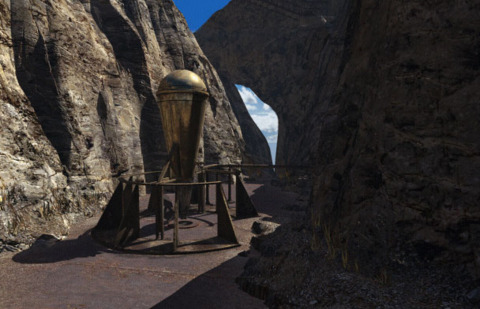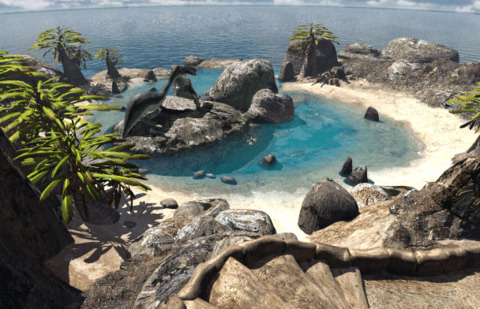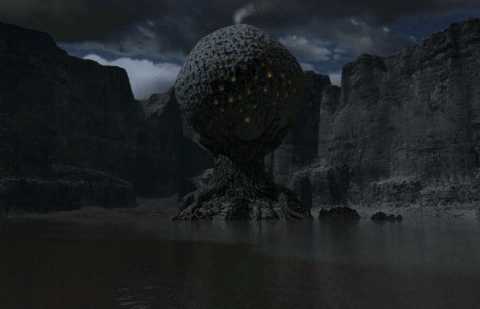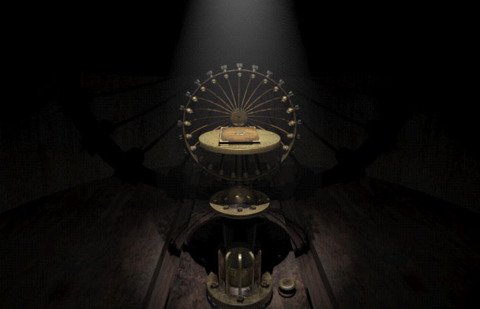Lost in the Myst: Part 6- Finishing Riven
By thatpinguino 11 Comments
When I left off my last blog post I had every intention of continuing the blow by blow of my playthrough of Riven. I thought I would continue narrating my revelations and frustrations with the game; however, in the intervening days I beat the game. I really wanted to see the ending so I powered through and I’m afraid some of the intermediate steps were lost in the shuffle. Also some of the intermediate steps are super convoluted and boring so let’s skip to the good stuff: the takeaways.
1. Riven has a great story, but it can be really poorly paced if you get stuck on any puzzles. Riven tells its story through both journal entries and environmental cues; and, thanks to the obtuseness of its puzzles, each form of storytelling is undercut. Though things like the Moiety knives, the five pointed star, and the hangman toy, Riven’s environment conveys a lot of information about Gehn’s rule over the islands and the resistance that rose up against him. That environmental storytelling is oftentimes reinforced and expanded upon by journals that you find later in the game.

It’s unfortunate that the bulk of the locations in the game are hidden behind puzzles that can range from run-of-the-mill unintuitive to Rube Goldberg-ian unintuative. Even worse, the journals are all quite long. After beating any of the large puzzles that dot the story, you often have to spend 10-20 minutes reading and carefully scribbling notes about what you could possibly do next. If I had no other games to play or other commitments, I might feel differently about the pacing. I’m finding that I have less and less time to play games nowadays and spending days beating my head against puzzles, only to be rewarded with a text log, just does did not do it for me, so I used a guide for some puzzles.
Now once you get to the story, it touches on ideas and themes that games rarely cover. The story of Riven is largely about designing, creating, and writing; and as a writer I love a good story about the power/danger of the pen. I really enjoyed the game’s explanation for why the world of Riven is as flawed and obsessed with the number five as it is: it is an age that was written by Ghen, a man who is a flawed writer and is obsessed with the number five. Ghen essentially wrote an escapist fantasy where he ruled as a god over a disempowered populous using book-based technologies and giant fish monsters that they could not oppose. It is incredible that the game features a clear critique of power fantasies, couched in a story of an indigenous uprising overthrowing a narcissistic colonizer. Ghen’s lack of self-awareness and complete belief in his own intelligence is believable and terrifying. I enjoyed that he thought that he could convince the main character to trust him, despite the monstrous aloofness he displays in all of his journals and artifices. I also really enjoyed Catherine’s struggle with being the messiah in her own society’s religious dogma. Her journal, full of self-doubt mixed with belief in her ultimate goal, was quite a read. I love this story despite its somewhat clunky delivery and pacing problems.

2. This game goes through tremendous pains to set up two puzzles. The animal circle puzzle and the marble puzzle are the two most elaborate puzzles I’ve ever seen in an adventure game. They both require information that is stretched across the entire game world and each piece of information is behind multiple puzzles. The sheer scale of it is impressive. However, all of that work ultimately led to an intensely frustrating experience that made me want to quit the game.
The animal circle, or Satan’s Baby Choo-Choo as I like to call it, requires you to learn the Riven numerical system, recognize the sounds of multiple fictional animals (apparently there are silhouettes you can use as well, but I couldn’t see them for 3 of the 5 animals), and select the proper animal pictures, in order, from a circle of over 20 animals (most of which you’ve never seen before). Just based on which animals I actually saw on the island, I was able to guess 4 of the 5 pictures I would ultimately have to use; however, identifying which animal made which sound was daunting. As I played through the game I took notes on each of the sounds that came out of the wooden eyes; but, it never occurred to me that they corresponded to animal sounds. Since each of them sounded like the type of abstract noises that populate much of the game world, I had no idea how they lined up with the animals in that circle. I could imagine that those unfamiliar sounds could come from any of the animals in that circle. As a result, I looked up the answer for this puzzle because wandering the island clicking on every eye and trying to track down the relationships did not seem like a good time.

Now that I actually know the solution, the logic makes a lot more sense and it seems like a brilliant puzzle. Now I understand why the weird water-dinosaurs keep respawning in the cove, the frogs are infinitely catchable, the Wahrk always returns to the undersea throne, and scarab beetles always flys around the forest. All of those recurring animal sounds are clues and they reoccur so that you don’t miss them. Now I understand that the eye in Ghen’s lab is the one that corresponds to the fish (not an eye that used to be in the sunner lagoon as I originally thought). Now I understand that the eyes are making animal noises, not random clicking and boat rocking noises. However, in the moment those disparate threads of information did not connect at all.
The game doesn’t even meet you half way by using real animals and recognizable animal sounds. Like so much in Riven, the game believes that its fiction and its environment are more important than your ability to progress in the game. This might make sense if all there was to the game was puzzles, if the story of Riven wasn’t worth a damn or didn’t exist. But, I was drawn in by the story! After hours of tromping around that fucking island, I finally found the end of a story thread and it was behind a puzzle that would take hours of wandering to solve. That shows a fundamental misunderstanding on the part of the developers as to how people could enjoy their game. They put their puzzles and their environment on a pedestal and their core narrative paid the price since it seems like most people either dropped the game around this point or looked up a guide. I’m of the opinion that if a large portion of your audience has to look outside of your game for guidance just to finish the game, you’ve made a design mistake. Fuck Satan’s Baby Choo-Choo.

The Marble puzzle, or the devil’s tiddlywinks as I like to call it, is just as obtuse as the animal circle, but it also commits a different and more annoying sin. The devil’s tiddlywinks requires you to graph out all five of the islands of Riven and identify where the spinning domes are on each island. You also need to go to each island to figure out which colored marble corresponds to which dome (except the small island, you need to guess that one). But, the precision of the graphing machine on the weird island full of multicolored pools of water isn’t as granular as the precision of the marble graph, so you could easily have to rearrange the damn marbles multiple times. The only way to check if the machine worked is to run down to a dome and see if the book inside actually works. That is a few minutes’ worth of clicking and gifs each way. This could easily lead to backtracking and fiddling for hours. Oh, and once you “solve” the puzzle, you need to hit a white button on the marble machine that totally looks like an indicator and not a switch. So there’s one more bit of backtracking for you. I understood how to solve that puzzle, I just looked up the answer because fuck doing the tedious back and forth.
Seeing these two puzzles really made me think about why puzzles are fun and how to communicate information. These two puzzles are largely about recognizing and translating symbols back and forth between multiple “languages;” however, they both seem better designed after you know the answer than they do during the discovery. These puzzles are like solving a bizzaro world Where’s Waldo book where the book has no title or cover to help you find Waldo. Instead, the book is full of barely perceptible scratch and sniff areas that smell of candy-cane so you can figure out Waldo’s coloration, a pair of broken glasses to figure out his glasses, and a blank page that you have view in black-light to see what his face looks like. Sure you can find Waldo, and once you do it will seem clever, but damn does it seem infuriatingly opaque in the moment.
In short, I really enjoyed most of Riven. Those two puzzles now seem really cool since I’ll never have to solve them again. In the moment they were the worst fucking puzzles I’ve ever seen. Fuck Riven. I love Riven.
P.S. Since I can't continue the Myst series due to Myst 3 and 4 being unavailable on any download services, I'm going to be transitioning to a new adventure game series to keep pace with @zombiepie. I think you'll all really appreciate our choice.
